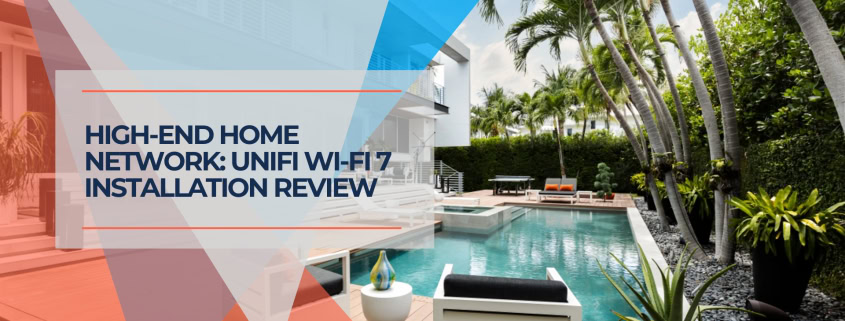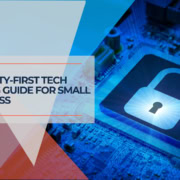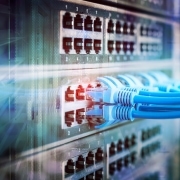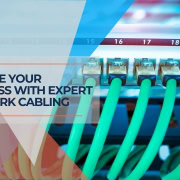Luxury Home Network Design: 4,500 sq ft Smart Home Integration Case Study
Table of Contents
- 1 Project Scope: Smart Home Requirements and Technology Integration
- 2 Coverage Challenges: Multi-Story, Outdoor Areas, and Entertainment Zones
- 3 Design Process: Site Survey, Coverage Modeling, and Aesthetic Considerations
- 4 Product Selection: Advanced UniFi Equipment for Residential Applications
- 5 Installation Challenges: Hidden Cabling and Architectural Constraints
- 6 Integration: Home Automation, Security Cameras, and Access Control
- 7 Performance Optimization: Fine-Tuning for Streaming, Gaming, and IoT Devices
- 8 Client Experience: Before and After Network Performance
- 9 Maintenance Plan: Ongoing Support Approach
- 10 Project Investment and Return on Value
- 11 Lessons Learned and Best Practices
- 12 Conclusion: Advanced Residential Networking Implementation
Project Overview: Comprehensive Network Infrastructure for Smart Home Integration
Challenge: Design and implement a comprehensive network infrastructure for a 4,500 square foot smart home in Coral Gables, integrating high-speed internet, automation systems, security, and entertainment while maintaining aesthetic appeal.
Solution: A comprehensive UniFi ecosystem leveraging Wi-Fi 7 technology, strategic access point placement, and integration with home automation platforms.
Result: Consistent high-speed performance throughout the property, supporting 75+ connected devices with business-grade reliability and residential design integration.
Modern upscale homes present unique networking challenges that extend beyond traditional residential requirements. When homeowners invest in advanced smart home technology, entertainment systems, and comprehensive security infrastructure, the underlying network must deliver business-level performance while maintaining the aesthetic standards expected in high-end residential environments.
This case study examines a recent project involving a 4,500-square-foot residence in Coral Gables. The integration of AT&T's multi-gigabit fiber service with a comprehensive UniFi network infrastructure created a foundation capable of supporting the demanding requirements of contemporary smart home living. The project demonstrates how thoughtful network design addresses both technical performance requirements and the aesthetic, integration, and reliability expectations of upscale residential environments.
Important Note: This case study represents one specific implementation approach. Costs, complexity, and requirements vary significantly based on location, specific needs, and local service availability. Many households can achieve excellent connectivity with simpler, more cost-effective solutions.
For context on broader business networking strategies, our comprehensive UniFi business networking guide provides additional insights into business-grade network design principles that apply to high-performance residential environments.
Project Scope: Smart Home Requirements and Technology Integration
Client Requirements and Lifestyle Considerations
The homeowners, a technology-executive family with three teenage children, required a network infrastructure capable of supporting both contemporary smart home technology and intensive recreational usage. Their specific requirements included:
Core Network Requirements
Entertainment and Media
Streaming Infrastructure: Support for simultaneous 4K and 8K streaming across 12 display devices
Gaming Performance: Low-latency connections for competitive gaming and VR applications
Media Server Integration: High-bandwidth access to centralized media storage systems
Smart Home Automation
IoT Device Support: Reliable connectivity for 40+ smart home devices
Automation Platforms: Integration with Apple HomeKit, Somfi motorized blinds, and automated pool systems
Environmental Controls: Smart HVAC, lighting, and pool/spa automation systems
Entertainment Integration: Samsung smart TVs and Sonos whole-home audio systems
Security and Surveillance
Video Surveillance: 12 4K security cameras with local and cloud storage
Access Control: Smart locks, gate controls, and visitor management
Perimeter Security: Motion detection and automated lighting systems
Professional and Educational Use
Home Office: Multiple high-definition video conferencing capabilities
Remote Work: VPN access and secure file sharing for executive responsibilities
Educational Support: Distance learning and online coursework for three students
Internet Service Foundation
The project began with AT&T's Fiber service, which provides symmetrical 2 Gbps connectivity. This service tier was selected to provide substantial headroom above the estimated 1.2 Gbps peak usage requirements, ensuring consistent performance during high-demand periods.
AT&T's BGW320-500 gateway serves as the fiber-to-Ethernet interface, with its 5 Gbps port providing sufficient capacity for current and future service upgrades. The gateway was configured in IP Passthrough mode, allowing the custom UniFi infrastructure to handle all routing, security, and traffic management functions.
Smart Home Platform Integration Requirements
Modern upscale homes typically integrate multiple smart home platforms, each with specific networking requirements:
- Apple HomeKit: Requires reliable mDNS and secure communication for device discovery and control
- Lutron Lighting: Uses proprietary protocols requiring consistent low-latency connectivity
- Security Systems: Demand dedicated network segments for compliance and reliability
- Entertainment Systems: High-bandwidth requirements for distributed audio/video
- HVAC Integration: IoT connectivity for zoned climate control and energy management
Coverage Challenges: Multi-Story, Outdoor Areas, and Entertainment Zones
Architectural Considerations
The 4,500 square foot residence presented several coverage challenges typical of upscale home construction:
Interior Coverage Challenges
Construction Materials: Concrete block construction with metal roofing elements creating RF interference
Room Layout: Large open spaces requiring multiple access points for optimal coverage
Multi-Story Design: Three-story layout with basement entertainment area requiring vertical coverage planning
Specialty Rooms: Wine cellar, safe room, and home theater with unique RF characteristics
Outdoor and Recreational Areas
Upscale homes extend connectivity requirements beyond interior spaces to encompass comprehensive outdoor coverage:
- Pool and Spa Area: 2,400 square feet outdoor entertainment zone requiring weather-resistant coverage
- Outdoor Kitchen: Smart appliances and entertainment systems require reliable connectivity
- Guest House: 800 square foot separate structure requiring dedicated coverage
- Property Perimeter: Security camera coverage extending 150 feet from main residence
- Driveway and Entry: Gate controls and visitor management systems requiring robust connectivity
Environmental Factors
South Florida's climate and environmental conditions influenced the network design:
- Hurricane Preparedness: Equipment protection and redundancy planning for severe weather
- Humidity Control: Proper equipment ventilation and moisture protection
- Landscaping Impact: Seasonal foliage changes affecting outdoor RF propagation
- Pool Area Challenges: Water reflection and moisture considerations for equipment placement
Design Process: Site Survey, Coverage Modeling, and Aesthetic Considerations
Comprehensive Site Assessment
The design process began with a detailed site survey examining technical requirements and aesthetic constraints. This process involved multiple stakeholder consultations to ensure the network design aligned with architectural and interior design standards.
Site Survey Methodology
Technical Assessment
RF Survey: Comprehensive radio frequency analysis using professional site survey tools
Interference Analysis: Identification of existing 2.4 GHz, 5 GHz, and 6 GHz interference sources
Cable Path Planning: Routing analysis for 25+ Ethernet runs through finished spaces
Aesthetic Coordination
Interior Design Consultation: Collaboration with interior designers for access point placement
Architectural Integration: Coordination with architectural features and lighting design
Equipment Concealment: Planning for hidden cable management and equipment locations
Usage Pattern Analysis
Device Density Mapping: Analysis of expected device concentration by area
Bandwidth Requirements: Peak usage estimation for different zones
Application Prioritization: QoS planning for critical applications and entertainment systems
Coverage Modeling and Access Point Placement
Unifi Designer's coverage modeling software optimized access point placement, accounting for architectural features, furniture placement, and aesthetic requirements. The modeling process considered:
- Signal Strength Optimization: Ensuring -67 dBm or better coverage throughout all occupied areas
- Capacity Planning: Multiple access points in high-density areas to prevent performance degradation
- Interference Mitigation: Channel planning to minimize co-channel interference
- Future Expansion: Infrastructure planning for potential coverage area additions
Aesthetic Integration Strategies
Upscale residential environments require network infrastructure that remains functionally unobtrusive while delivering reliable performance. The design incorporated several aesthetic strategies:
Design Principle: Effective residential network installations deliver reliable performance while remaining unobtrusive to residents and guests.
- Recessed Mounting: Access points installed flush with ceiling surfaces using architectural ceiling boxes
- Color Coordination: Custom-painted access points matching interior color schemes
- Strategic Placement: Equipment positioned in utility areas, closets, and concealed locations
- Cable Management: All network cabling routed through walls and attic spaces with no visible runs
Product Selection: Advanced UniFi Equipment for Residential Applications
Core Infrastructure Components
The network foundation was built using business-grade UniFi equipment selected for both performance capabilities and reliability appropriate for residential applications:
Primary Network Infrastructure
Gateway and Routing
UniFi Dream Machine Pro Max: Central gateway providing 5 Gbps IDS/IPS throughput and dual 3.5″ drive bays for video surveillance storage (view specifications)
Redundant Power: APC Smart-UPS 2200VA ensures continuous operation during power fluctuations.
Switching Infrastructure
UniFi Switch Pro Max 24 PoE (Primary): Main distribution switch with 8x 2.5 Gbps PoE++ ports for high-performance devices (compare models)
UniFi Switch Pro Max 24 PoE (Secondary): Dedicated switch for security cameras and additional network devices
10 Gbps Backbone: SFP+ DAC connections ensuring no bottlenecks between core components
Wireless Access Points
UniFi U7 Pro Max (3 units): Wi-Fi 7 access points with 2.5 Gbps uplinks for interior coverage (~$280 each) (see performance specs)
UniFi U7 Outdoor (1 unit): Weather-resistant access point for pool area and patio coverage
Strategic Placement: Optimized for both performance and aesthetic integration
Wi-Fi 7 Technology Advantages
The selection of Wi-Fi 7 access points provided several advantages for smart home applications:
- Enhanced Capacity: Support for 200+ concurrent devices without significant performance degradation
- 6 GHz Band Utilization: Access to less congested spectrum for high-performance applications
- Multi-Link Operation: Simultaneous connections across multiple bands for improved reliability (when available via firmware update)
- Reduced Latency: Important for gaming, video conferencing, and real-time automation systems
Specialized Equipment for Residential Applications
Beyond standard networking equipment, the project incorporated specialized components addressing residential smart home requirements:
Specialized Components
UniFi Protect Systems: 12x AI cameras with facial recognition and license plate detection
UniFi Access Controllers: Smart lock integration and visitor management
Environmental Monitoring: Temperature and humidity sensors for equipment protection
Equipment Redundancy and Reliability
Upscale residential applications often require enhanced reliability. The design incorporated several redundancy measures:
- Dual Internet Connections: Primary AT&T fiber with Comcast cable backup via UniFi failover
- Power Protection: UPS systems for all critical network components
- RAID Storage: Dual drive redundancy for security video storage
- Spare Equipment: On-site backup access points and switches for rapid replacement
Installation Challenges: Hidden Cabling and Architectural Constraints
Cable Infrastructure Implementation
Installing business-grade network cabling in a finished home requires careful planning and execution to maintain aesthetic standards while ensuring optimal performance:
Installation Complexity Factors
Finished Walls: Careful planning is required to minimize drywall damage
High-Quality Finishes: Protection of upscale materials during installation
Concealed Routing: Cable paths through architectural elements and decorative features
Code Compliance: Plenum-rated cabling and fire-stopping requirements
Architectural Integration Challenges
The installation process required coordination with multiple trades and careful consideration of architectural elements:
- Beam and Column Navigation: Routing cables around structural elements without compromising integrity
- HVAC Coordination: Integration with existing ductwork and avoiding interference
- Electrical Coordination: Proper separation from power lines and compliance with code requirements
- Plumbing Avoidance: Careful routing to avoid water lines and potential leak areas
Specialized Installation Techniques
Upscale home installations often require specialized techniques to maintain aesthetic standards:
Advanced Installation Methods
Minimally Invasive Techniques
Micro-Trenching: Sub-surface cable routing for outdoor connections
Flexible Conduit Systems: Future-proofing for cable additions and changes
Architectural Ceiling Boxes: Flush-mounted access point installations
Aesthetic Protection
Wall Protection Systems: Plastic sheeting and temporary barriers during installation
Dust Control: HEPA filtration during drilling and cutting operations
Surface Restoration: Professional drywall repair and paint matching
Quality Assurance
Cable Testing: Comprehensive certification of all network runs
Performance Verification: Speed testing at every access point location
Documentation: Complete as-built drawings for future maintenance
Timeline and Project Coordination
The installation process required careful coordination to minimize disruption to the occupied residence:
- Phase 1 (Week 1): Core infrastructure and equipment room setup
- Phase 2 (Week 2): Interior cabling and access point installation
- Phase 3 (Week 3): Outdoor cabling and weather-resistant equipment
- Phase 4 (Week 4): System configuration, testing, and optimization
Integration: Home Automation, Security Cameras, and Access Control
Smart Home Platform Integration
Modern upscale homes typically incorporate multiple automation platforms, each requiring a specific network configuration for optimal performance. The network design accommodated several critical integration requirements:
Platform-Specific Requirements
Apple HomeKit Integration
Network Requirements: Reliable mDNS (Bonjour) service for device discovery
Security Configuration: Proper VLAN configuration for secure device communication
Device Connectivity: Stable connections for HomeKit-enabled devices and controllers
Hub Placement: Strategic placement of Apple TV and HomePod devices for optimal coverage
Lutron Lighting Integration
Protocol Support: Network configuration for Lutron's Clear Connect protocol
Timing Sensitivity: Low-latency requirements for responsive lighting control
Device Registration: Proper network settings for device enrollment
Security System Integration
Isolated Networks: Separate VLANs for security cameras and access control
Redundant Connectivity: Multiple network paths for critical security functions
Compliance Requirements: Network configuration meets insurance and regulatory standards
Video Surveillance Implementation
The 12-camera UniFi Protect system required careful planning to ensure reliable recording and remote access capabilities:
- Camera Placement Strategy: Comprehensive coverage with minimal aesthetic impact
- Bandwidth Management: Intelligent recording settings to optimize storage and network usage
- Storage Redundancy: RAID 1 configuration in UDM Pro Max with off-site backup
- Mobile Access: Secure remote viewing through the UniFi Protect mobile application
- AI Features: Facial recognition and license plate detection for enhanced security
Access Control and Visitor Management
The UniFi Access system provided comprehensive access control throughout the property:
Integration Success: The unified UniFi ecosystem enabled integration between networking, security cameras, and access control, providing a single management interface for all systems.
- Smart Lock Integration: Four UniFi Access controllers managing entry points
- Visitor Management: Temporary access codes and mobile app integration
- Activity Logging: Comprehensive access logs with video correlation
- Emergency Features: Remote lockdown capabilities and emergency access
Performance Optimization: Fine-Tuning for Streaming, Gaming, and IoT Devices
Quality of Service Configuration
Smart homes generate diverse network traffic requiring sophisticated traffic management to ensure optimal performance across all applications:
Traffic Prioritization Strategy
Critical Applications (Highest Priority)
Security Systems: Cameras, access control, and alarm systems
Voice Communications: VoIP and video conferencing traffic
Home Automation: Apple HomeKit, Samsung smart TVs, and Sonos audio communications
High-Priority Applications
Gaming Traffic: Low-latency requirements for competitive gaming
Live Streaming: Real-time video streaming and content creation
Video Conferencing: Professional and educational video calls
Standard Priority
Media Streaming: Netflix, Disney+, and other entertainment services
Web Browsing: General internet usage and social media
File Transfers: Cloud synchronization and backup operations
Background Priority
Software Updates: Device and application updates
Cloud Backup: Off-site data backup operations
IoT Telemetry: Smart device status reporting and analytics
Network Segmentation and Security
The network architecture incorporated multiple VLANs to ensure security and performance isolation:
- Guest Network: Isolated access for visitors with internet-only connectivity
- IoT Segment: Dedicated network for smart home devices with controlled internet access
- Security Network: Isolated segment for cameras and access control systems
- Media Network: High-bandwidth segment for entertainment and streaming devices
- Personal Devices: Smartphones, laptops, and tablets with full network access
Wi-Fi Optimization Strategies
With four access points covering 4,500 square feet plus outdoor areas, careful optimization was required to prevent interference and ensure optimal performance:
Wi-Fi Performance Optimization
Channel Planning: Strategic 5 GHz and 6 GHz channel assignment to minimize interference
Power Optimization: Adjusted transmit power to prevent access point overlap
Band Steering: Intelligent client distribution across 2.4 GHz, 5 GHz, and 6 GHz bands
Load Balancing: Even client distribution across multiple access points
Performance Monitoring and Analytics
Continuous monitoring helps ensure the network maintains optimal performance as usage patterns evolve:
- Real-Time Monitoring: UniFi Network Application provides continuous performance visibility
- Usage Analytics: Application usage patterns and bandwidth consumption analysis
- Device Health Monitoring: Proactive identification of failing or misconfigured devices
- Capacity Planning: Analysis of growth trends and capacity requirements
Client Experience: Before and After Network Performance
Pre-Implementation Challenges
Before the network upgrade, the family experienced several connectivity and performance issues typical of homes with inadequate network infrastructure:
Previous Network Limitations:
- Inconsistent Wi-Fi coverage with dead zones in approximately 30% of the residence
- Frequent buffering during 4K streaming in multiple rooms
- Smart home automation delays and device disconnections
- Poor video call quality is affecting remote work productivity
- Gaming lag and disconnections are impacting recreational use
- Security camera recording failures due to network instability
Post-Implementation Results
The new UniFi infrastructure delivered measurable improvements across all aspects of network performance:
Performance Achievements:
- Complete property coverage with signal strength exceeding -65 dBm
- Speed test results of 1.2-1.8 Gbps measured at various locations using Wi-Fi 7 compatible devices
- Eliminated buffering during simultaneous 4K/8K streaming across 12 devices
- Sub-20ms latency for gaming and real-time applications
- 99.9% uptime for all smart home automation systems during the monitoring period
- Reliable video conferencing quality supporting executive responsibilities
Quantified Performance Metrics
Professional testing conducted three months after installation demonstrated the network's capabilities under optimal conditions:
Measured Performance Results*
Speed and Throughput
Wired Performance: 1.95 Gbps download / 1.93 Gbps upload at all 2.5 Gbps ports
Wi-Fi 7 Performance: 1.2-1.6 Gbps on 6 GHz band with compatible devices
Wi-Fi 6E Performance: 800-1,200 Mbps on 5 GHz band with existing devices
Latency and Reliability
Internet Latency: 2-6ms to major content delivery networks
Internal Latency: Sub-2ms between local devices
Uptime Achievement: 99.97% availability over initial 6-month period
Device Capacity
Concurrent Devices: 78 devices during peak usage periods
Peak Bandwidth: 950 Mbps aggregate during evening entertainment hours
Quality Metrics: No dropped connections or performance degradation during testing
*Results may vary based on internet service provider, client devices, environmental factors, and network usage patterns.
User Experience Improvements
Beyond technical metrics, the network upgrade delivered qualitative improvements in daily technology use:
- Seamless Mobility: Devices maintain connectivity while moving throughout the property
- Instant Responsiveness: Smart home controls respond immediately to commands
- Professional Capability: Home office functionality matching corporate office standards
- Entertainment Performance: Consistent streaming and gaming experiences across all devices
- Guest Experience: Visitors experience reliable Wi-Fi performance throughout the property
Maintenance Plan: Ongoing Support Approach
Proactive Monitoring and Management
Advanced residential networks require ongoing attention to maintain optimal performance and security. The maintenance plan incorporates both automated monitoring and regular professional oversight:
Comprehensive Maintenance Framework
Daily Automated Monitoring
Performance Alerts: Automated notifications for speed degradation or connectivity issues
Security Monitoring: Continuous surveillance for unauthorized access attempts
Device Health Checks: Automatic monitoring of all network equipment status
Backup Verification: Daily confirmation of security video recording and storage
Weekly Professional Review
Performance Analysis: Review of network utilization and performance trends
Security Updates: Installation of firmware updates and security patches
Capacity Assessment: Analysis of growing bandwidth and device requirements
Issue Resolution: Proactive addressing of emerging performance concerns
Monthly Comprehensive Assessment
Coverage Optimization: RF analysis and access point performance tuning
Configuration Review: Assessment of QoS settings and traffic prioritization
Security Audit: Comprehensive review of access controls and security policies
Future Planning: Technology roadmap updates and expansion planning
Emergency Response and Support
Technology-dependent households often require prompt response to network issues that could impact business operations or home security:
- 24/7 Emergency Support: Direct contact for critical network failures
- 4-Hour Response Time: On-site technical support for urgent issues
- Spare Equipment Inventory: Pre-positioned backup equipment for rapid replacement
- Remote Troubleshooting: Immediate diagnostic capabilities through UniFi Cloud Access
Technology Evolution and Upgrades
The network infrastructure includes planning for technology advancement and capacity growth:
Future-Proofing Strategy: The installed infrastructure supports immediate upgrades to 5 Gbps internet service and provides growth capacity for emerging smart home technologies.
- Annual Technology Assessment: Review of new UniFi products and upgrade opportunities
- Capacity Expansion: Addition of access points or switching capacity as needed
- Service Tier Upgrades: Support for internet service increases up to 5 Gbps
- Smart Home Integration: Incorporation of new automation platforms and IoT devices
Project Investment and Return on Value
Investment Overview
The complete network infrastructure represented a significant investment, reflecting the advanced equipment and professional installation required for this level of residential implementation:
Example Investment Breakdown*
Core Network Equipment
UniFi Hardware: $7,500-$9,500 (gateway, switches, access points, cameras)
Power Protection: $1,000-$1,400 (UPS systems and surge protection)
Cabling Infrastructure: $1,800-$2,400 (Cat 6a cabling and termination)
Professional Services
Design and Engineering: $1,500-$2,100 (site survey and system design)
Installation Services: $4,800-$6,000 (cabling, equipment installation, configuration)
Testing and Optimization: $800-$1,000 (performance verification and tuning)
Total Project Investment
Complete Implementation: $18,000-$25,000*
Annual Maintenance: $2,000-$3,000 (ongoing support and optimization)
Per Square Foot Cost: $4.00-$5.50 for 4,500 sq ft coverage
*Costs vary significantly based on location, complexity, local labor rates, and specific requirements. This represents one specific implementation and should not be used for budgeting purposes without local consultation.
Value Delivered
The network infrastructure investment can provide measurable returns across multiple areas:
- Productivity Enhancement: Reliable high-speed connectivity supporting remote work requirements
- Property Value: Advanced network infrastructure may increase resale appeal to technology-focused buyers
- Security Benefits: Comprehensive surveillance and access control capabilities
- Entertainment Value: Consistent streaming and gaming experiences
- Smart Home Enablement: Foundation for current and future automation expansion
Comparative Analysis
The UniFi ecosystem provided considerable value compared to alternative solutions:
Cost Efficiency: Comparable business-grade solutions from traditional enterprise vendors would typically cost 150-200% more and require annual licensing fees of $4,000-$6,000.
Lessons Learned and Best Practices
Critical Success Factors
Several key factors contributed to the project's success and can guide similar residential network implementations:
- Early Stakeholder Engagement: Involvement of interior designers and architects from project inception
- Comprehensive Planning: Detailed site surveys and coverage modeling before equipment selection
- Quality Installation: Professional-grade cabling and equipment mounting techniques
- Performance Verification: Thorough testing and optimization before project completion
- Documentation Quality: Complete as-built drawings and configuration documentation
Common Challenges and Solutions
Advanced residential networking projects present unique challenges requiring specialized approaches:
Challenge Resolution Strategies
Aesthetic Integration: Early coordination with design professionals prevents conflicts
Performance Expectations: Clear communication of capabilities and limitations
Installation Complexity: Detailed planning and skilled technicians minimize disruption
Technology Evolution: Future-proof infrastructure design accommodates upgrades
When This Approach May Not Be Appropriate
This level of network infrastructure investment is not suitable for all households:
- Basic Connectivity Needs: Simple internet usage may be adequately served by ISP-provided equipment
- Budget Constraints: Significant upfront and ongoing costs may not be justified for all users
- Technical Complexity: Ongoing management requires technical knowledge or professional support
- Temporary Living Situations: Short-term residence may not justify the investment
Industry Trends and Future Considerations
The residential networking market continues to evolve with several emerging trends:
- Wi-Fi 7 Adoption: Growing device support driving access point upgrade cycles
- IoT Device Growth: Increasing smart home device density requires expanded capacity
- Security Requirements: Enhanced cybersecurity measures for connected homes
- Service Integration: Unified platforms combining networking, security, and automation
Conclusion: Advanced Residential Networking Implementation
The implementation of this 4,500 square foot smart home network demonstrates that business-grade performance can be achieved in residential environments through careful planning, quality equipment selection, and professional installation practices. The UniFi ecosystem provided an appropriate balance of performance, reliability, and aesthetic integration required for upscale residential applications.
Project Success Metrics:
- Complete property coverage with business-grade performance
- Support for 75+ concurrent devices without significant degradation
- High-speed connectivity is delivered throughout the residence
- Successful integration with multiple smart home platforms
- Professional aesthetics maintains residential design standards
- Comprehensive security and access control integration
The project is a reference for advanced residential networking, demonstrating that thoughtful design and quality implementation can create network infrastructure that enhances rather than compromises the living environment. As smart home technology continues to advance and internet speeds increase, the foundation established by this UniFi deployment provides the scalability and performance necessary to support future innovations.
Important Considerations
This case study represents one specific approach to residential networking that may not be appropriate for all households. Many homes can achieve excellent connectivity with simpler, more cost-effective solutions. Before implementing a similar system, consider your specific needs, budget, and technical requirements. Professional consultation is recommended for complex installations.
For homeowners considering similar network upgrades, this case study illustrates the importance of working with experienced professionals who understand the technical requirements and aesthetic considerations important for residential environments. Investing in quality infrastructure can provide benefits through improved productivity, enhanced security, and better entertainment experiences for technology-focused households.
For additional insights into business-grade networking solutions, our comprehensive guide on future-proofing office networks with UniFi provides parallel strategies applicable to high-performance residential environments. Our analysis of technology stacks for small teams offers insights into integrating networking with broader technology ecosystems.
Ready to explore UniFi solutions for your home? Compare UniFi Dream Machine Pro Max specifications or review Wi-Fi 7 access point performance to start planning your network upgrade.
iFeelTech specializes in commercial network design throughout South Florida. Our expertise in home technology integration helps ensure your network infrastructure meets high-performance and aesthetic integration standards. Contact us to discuss your smart home networking requirements and explore how business-grade infrastructure can enhance your residential technology experience.
Disclosure: iFeelTech participates in the Ubiquiti Creator Program.
We may earn a commission when you purchase UniFi products through our links at no
additional cost to you. Our recommendations are based on professional experience and testing.











Leave a Reply
Want to join the discussion?Feel free to contribute!